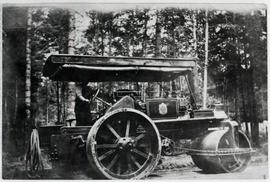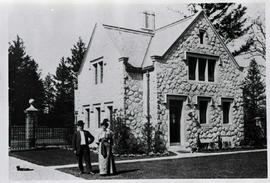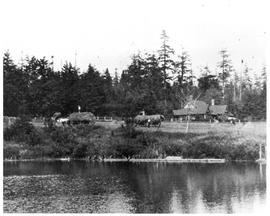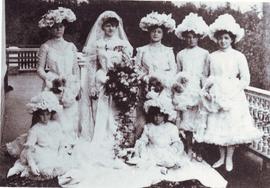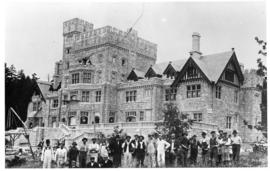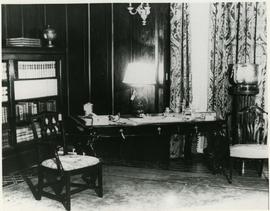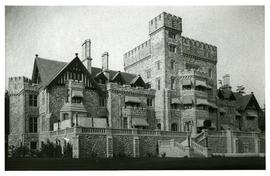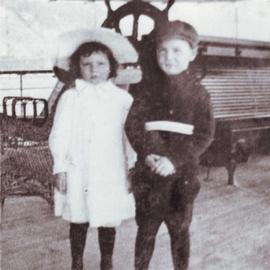The upper Japanese garden at Hatley Park was designed by Japanese landscape architect Isaburo Kishida. The garden was installed in 1909 and developed by Tadashi Noda from 1913-1927. This bench was located in the upper Japanese garden. Rose swags (ropes for trailing roses) are visible in the background, framing the rose garden area.
Hatley Castle from the south. Terrace lawn, people in uniform walking on terrace, indicates this is Naval college era. Hatley Castle was designed by renowned British Columbia architect Samuel Maclure for James Dunsmuir. Using only the finest materials, builders, stonemasons and detail carpenters only took 18 months to construct the building from 1908 until 1910. It was sold in 1940 to the Canadian Government and became HMCS Royal Roads, a naval training establishment.
castle from north east under construction with stonemasons in front. Walls are mostly built and wood framing for roof is in place. Hatley Castle was designed by renowned British Columbia architect Samuel Maclure for James Dunsmuir. Using only the finest materials, builders, stonemasons and detail carpenters only took 18 months to construct the building from 1908 until 1910. The construction was overseen by contractor, Thomas Catterall.
Top row L-R: Robin Dunsmuir; Maude (Shoobert) Dunsmuir; John Hope; Maurice Bromley-Wilson; Arthur Bromley; Maye (Dunsmuir) Bromley; Guy Audain. Middle row: Bessie (Dunsmuir) Hope; Laura (Surles) Dunsmuir; James 'Boy' Dunsmuir; James Dunsmuir; Sarah 'Byrdie' (Dunsmuir) Audain. Bottom row: Marion Dunsmuir; Kathleen Dunsmuir; Dola Dunsmuir; James Audain; Elinor Dunsmuir; Muriel Dunsmuir
John and Olive Jameson were married in 1921 and had 3 children: John (Jack), Elizabeth (Betty), and Alice.
The gate house on Sooke Road was part of the estate developments made by Brett and Hall from 1912-1914. It was occupied for 20 years by Herman and Theresa Eng. Herman Eng was head gardener at Hatley Park 1913-1932.
The greenhouse and conservatory were constructed and installed by the Lord and Burnham Company and they later used the estate installation in their promotional material. The glass house complex had a full time manager and required 60 tons of coal and 200 cords of wood per year to heat. The ornate conservatory pictured had a central dome of about 30 ft square, with two side galleries, each 60 ft long. Flowers were grown inside that were intended for display in the castle and in later years it was also used for food production. According to a former gardener, interviewed in the 1950s, Laura Dunsmuir said that the conservatory was an extravagance in a private garden and that it should be in a public park.
Image shows the farmhouse at Roland Stuart's Hatley Park estate. In the foreground, the pond that would later form part of the Dunsmuirs' formal gardens is visible. Farm labourers are gathering hay.
In the summer of 1903, architect Ridgeway-Wilson was engaged to make some alterations to the home, including the use of a half timber and plaster finish. It is possible that this image post dates the improvements made.
Pond has no stone lining and floating pavilion is not yet constructed although there is a gazebo structure on what appears to be an island in the pond. Castle is visible in the background. The upper Japanese garden at Hatley Park was designed by Japanese landscape architect Isaburo Kishida. The garden was installed in 1909 and developed by Tadashi Noda from 1913-1927.
Sarah Byrd 'Byrdie' Dunsmuir married Guy Audain, October 29, 1901. Photo is taken at the Dunsmuir family home, Burleith. L-R back: Maye; Sarah 'Byrdie'; Bessie; Marion; Elinor. Front: Muriel; Kathleen
Hatley castle from south east with construction crew in front. Most windows have been installed, some scaffolding remains around terrace wall.
Hatley Castle was designed by renowned British Columbia architect Samuel Maclure for James Dunsmuir. Using only the finest materials, builders, stonemasons and detail carpenters only took 18 months to construct the building from 1908 until 1910. The construction was overseen by contractor, Thomas Catterall.
The Italian garden to the west of the castle was added as part of extensive development of the Hatley Park estate by Boston based landscape architects, Brett and Hall from 1912-1914.
castle library, showing south east corner with bookshelves and a writing desk. A lamp is lit on the desk and all items have lot tags attached ready for auction.
The stables and garage building was added as part of extensive development of the estate by Boston based landscape architects, Brett and Hall from 1912-1914. The area in the foreground of the picture was later used for cereal crop growing.
The walled garden was added as part of extensive development of the estate by Boston based landscape architects, Brett and Hall from 1912-1914. The walled garden contained vegetable and fruit crops as well as the greenhouse complex.
Newly completed Hatley Castle from site of future croquet lawn (before Italian and croquet are installed). Note screens on west end of terrace. Hatley Castle was designed by renowned British Columbia architect Samuel Maclure for James Dunsmuir. Using only the finest materials, builders, stonemasons and detail carpenters only took 18 months to construct the building from 1908 until 1910.
Newly installed two humped bridge to island and young landscaping on the island. Castle is visible in the background. The upper Japanese garden at Hatley Park was designed by Japanese landscape architect Isaburo Kishida. The garden was installed in 1909 and developed by Tadashi Noda from 1913-1927.
Hatley Castle from south east under construction. Two men in foreground. Windows not yet installed.
Hatley Castle was designed by renowned British Columbia architect Samuel Maclure for James Dunsmuir. Using only the finest materials, builders, stonemasons and detail carpenters only took 18 months to construct the building from 1908 until 1910. The construction was overseen by contractor, Thomas Catterall.
James Dunsmuir Jr, known to his family as ‘Boy’, and to others as Jim, was born in 1894. His childhood education took place at Loretto, a private school in Scotland, where he became an accomplished lightweight boxer. After he completed his schooling, Jim went to Montreal and worked as a private secretary at a bank. With a lifelong love of horses, it came as no surprise that he enlisted in the B.C. Horse and later the 2nd Canadian Mounted Rifles (CMR) stationed at Willows fairground in Victoria at the outbreak of the First World War. Having taken the cavalry school course in Winnipeg, Jim was made a lieutenant, but he quickly grew frustrated with the seemingly endless ceremonial duties of the CMR. Anxious to contribute to the war in Europe, Jim resigned his commission and set sail for England to join a British cavalry regiment. Jim departed from New York on May 1, 1915, on the luxury passenger ship Lusitania. Tragically, as the ship neared the Irish coast on May 7, it was hit by a German torpedo and sank. His body was never recovered.
This photo would have been taken between 1914 and 1915, while James Dunsmuir Jr was stationed in Victoria. There are similar versions of this photograph in this and other collections.
New pavilion is installed, as is floating bridge. The upper Japanese garden at Hatley Park was designed by Japanese landscape architect Isaburo Kishida. The garden was installed in 1909 and developed by Tadashi Noda from 1913-1927.
castle library showing east wall with bookshelves and a portrait painting (possibly Dola Dunsmuir or Marion Bromley) with writing desk on right and chairs gathered in the centre ready for auction




